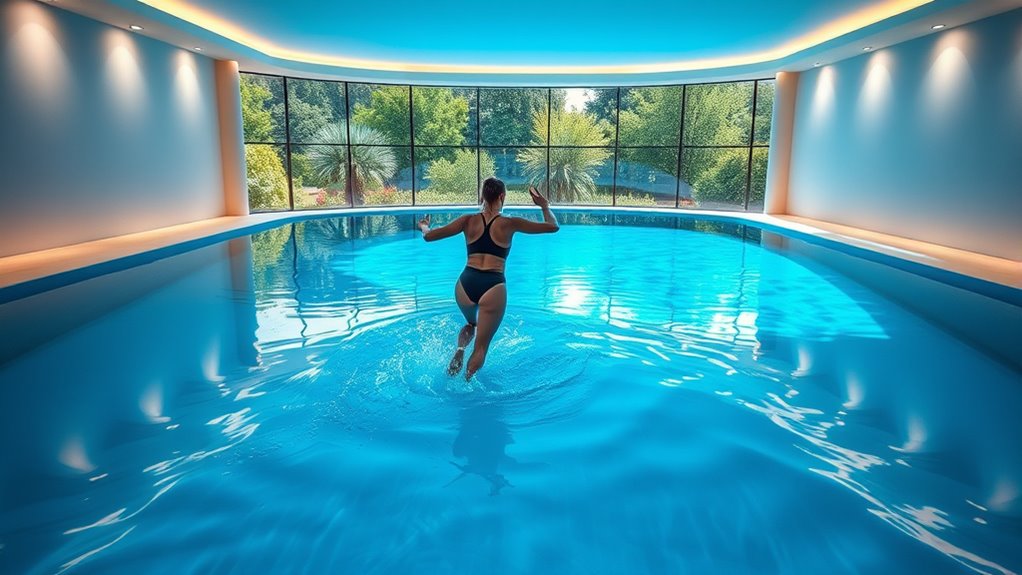You can boost your fitness in an endless pool with versatile exercises like treading water for endurance, resistance running for strength, aqua lunges for lower-body sculpting, water push-ups for upper-body power, and plank variations for core stability. Incorporate jumping jacks and swimming strokes to elevate your heart rate and full-body conditioning. Plus, try HIIT workouts for intense calorie burn and muscular endurance. Keep going to discover how these exercises can transform your pool routine effectively.
Key Takeaways
- Incorporate water-based HIIT intervals like sprints, jumps, and fast kicks for full-body cardiovascular conditioning.
- Use resistance exercises such as water push-ups and resistance running to build upper and lower body strength.
- Perform aqua lunges, side leg raises, and leg lifts to sculpt and tone the lower body with low-impact resistance.
- Engage core stability with plank variations and water-supported balance exercises for improved strength and endurance.
- Combine swimming strokes with water resistance drills to maximize muscle engagement and overall workout intensity.
Treading Water for Endurance and Cardio
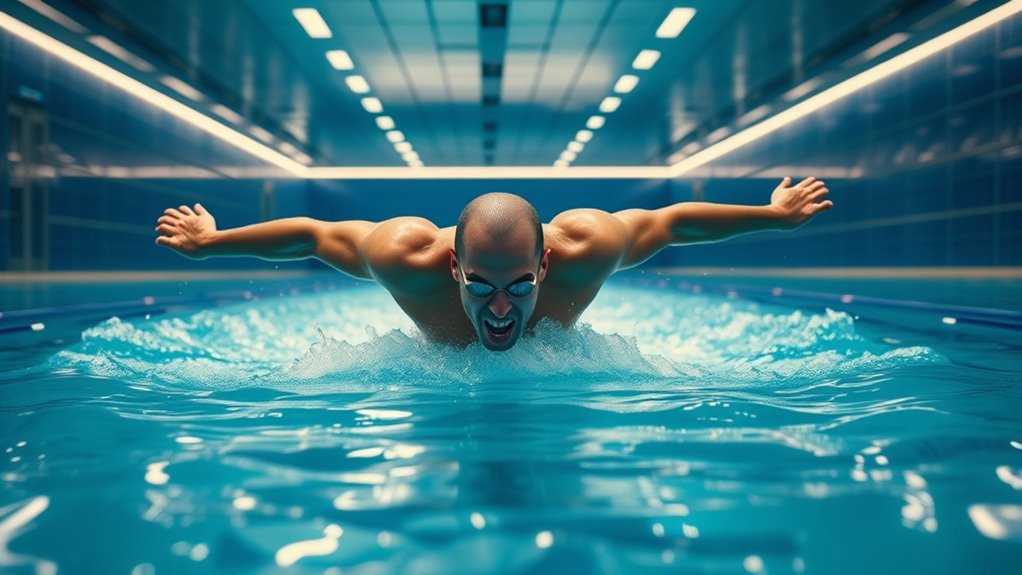
Treading water is an effective way to build both endurance and cardiovascular fitness in an endless pool. As you stay afloat, you engage your core, legs, and arms, pushing your muscles to work continuously. This exercise increases your heart rate, making it a great cardio workout without impacting your joints. You can vary your pace or incorporate different movements—like scissor kicks or eggbeater—to target specific muscle groups and challenge your stamina. Treading water also improves your breathing efficiency, helping you develop better lung capacity. Since it’s low-impact, you can perform it for extended periods without risking injury. Consistent practice boosts your overall endurance, making everyday activities easier and preparing you for more intense workouts.
Resistance Running for Strength Building

Building on your cardiovascular endurance, resistance running in an endless pool is an effective way to develop muscle strength and power. By adding resistance, you challenge your muscles more intensely, improving both speed and stability. You can vary the intensity by adjusting your pace and water turbulence, making each session customizable. To maximize results, focus on controlled, powerful strides that engage your core and leg muscles. Incorporate different techniques to target various muscle groups and prevent plateaus. Properly inflating Presta valve tires ensures optimal resistance and safety during your workouts.
Aqua Lunges to Sculpt Lower Body
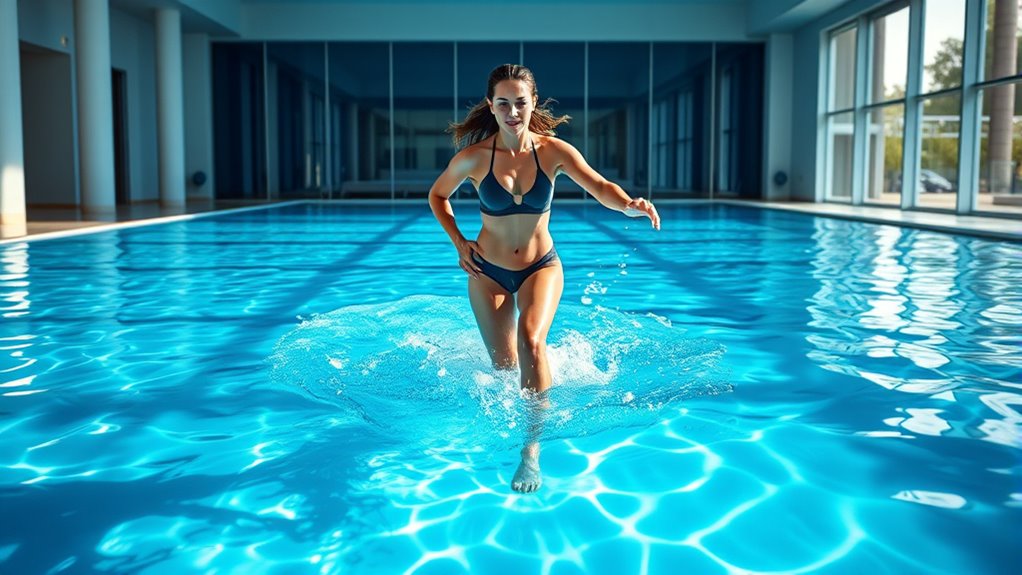
Aqua lunges are an effective way to sculpt your lower body by engaging multiple muscle groups simultaneously. As you step forward into a lunge, your quadriceps, hamstrings, glutes, and calves activate to stabilize and propel you through the movement. The water’s resistance adds an extra layer of challenge, making each lunge more effective without putting stress on your joints. To perform this exercise, start in a standing position, then step one foot forward and lower your hips until both knees are bent at about 90 degrees. Push through your front heel to return to standing. Repeat with the other leg, maintaining proper form. Aqua lunges strengthen your legs, improve balance, and boost endurance—all while minimizing impact. Incorporating Kia Tuning concepts like suspension upgrades can inspire ideas for enhancing your workout equipment or environment.
Pool Plank Variations for Core Stability

You can challenge your core with different plank position techniques in the pool to boost stability. Incorporating dynamic movements into your planks keeps your muscles engaged and improves endurance. Let’s explore how these variations can maximize your core workout. Engaging in effective training strategies can further enhance your results and prevent plateaus.
Plank Position Techniques
Mastering plank variations in the pool can substantially boost your core stability and overall strength. To begin, focus on proper form: keep your body in a straight line from head to heels, engaging your core muscles. Support your weight on your forearms or hands, depending on the variation. Maintain a neutral neck by looking down or slightly ahead, avoiding sagging hips or raised buttocks. For added challenge, try side planks, balancing on one forearm with hips elevated, or incorporate slight hip dips to activate obliques. Guarantee your elbows are aligned under your shoulders for stability. Keep your breathing steady and controlled throughout each hold. These techniques help you maximize core engagement while minimizing strain, making your plank sessions more effective and safe in the water. proper form is essential to prevent injury and ensure you get the most benefit from each exercise.
Dynamic Plank Movements
Building on your knowledge of static planks, incorporating dynamic movements can markedly enhance your core stability. In the pool, you can perform these movements safely, adding challenge and variety. For example, try shifting your weight side to side or moving your arms forward and back while maintaining a plank position. You can also lift one arm or leg at a time, engaging stabilizer muscles more intensely. These variations force your core to adapt quickly, improving strength and endurance. Keep your hips steady and avoid sagging or piking. Use the water’s resistance to your advantage, making each move more effective. Additionally, monitoring your form and proper technique can help prevent injury and maximize benefits. Incorporate these dynamic plank movements into your routine to boost core stability, balance, and overall functional strength in a safe, low-impact environment.
Water-Based Jumping Jacks to Boost Heart Rate

Have you ever wondered how to elevate your heart rate effectively while minimizing impact on your joints? Water-based jumping jacks are perfect for this. In the pool, you stand upright with your arms at your sides. Jump your legs outward while raising your arms overhead, then jump back to the starting position. The water’s resistance makes each movement more challenging without the jarring impact of traditional jumping jacks. Keep a steady pace to maintain an elevated heart rate. Focus on controlled, deliberate motions to maximize calorie burn and cardiovascular benefits. Because of the water’s buoyancy, your joints stay protected, reducing injury risk. Incorporating aerobic exercises like water-based jumping jacks can also help improve your overall cardiovascular health. Include these jumping jacks into your routine to improve endurance, burn calories, and boost overall fitness—all without stressing your joints.
Flutter Kicks for Toned Legs and Abs
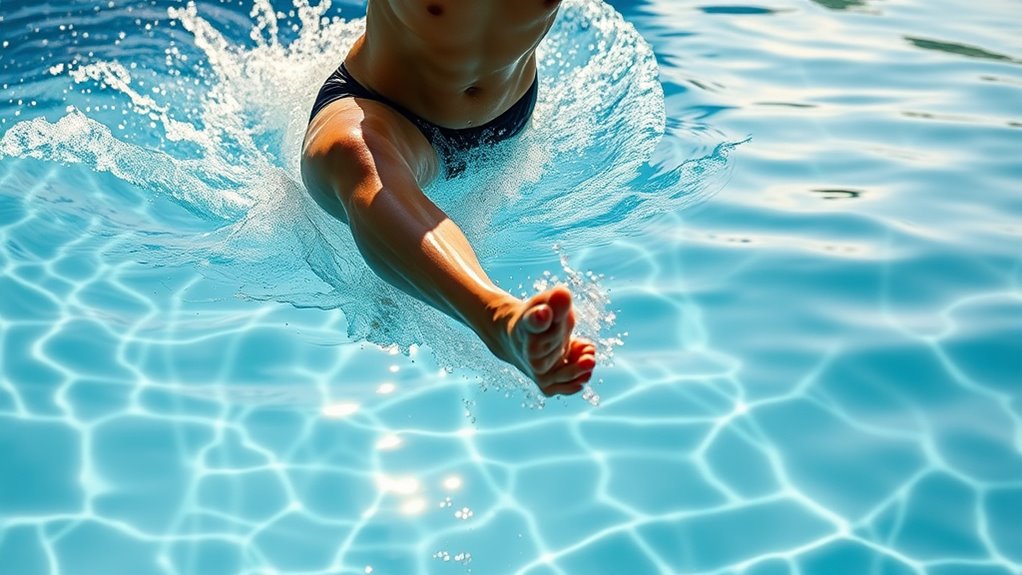
To get the most out of flutter kicks, focus on maintaining proper technique to avoid strain. Keep your legs straight and move from your hips, not your knees. Engage your core muscles to stabilize your body and maximize toning in your legs and abs.
Proper Flutter Technique
Mastering proper flutter technique is essential for maximizing the effectiveness of your kicks and avoiding injury. Keep your legs straight but relaxed, initiating movement from your hips rather than your knees. Engage your core to stabilize your body and prevent unnecessary swaying. Your ankles should remain flexed, with toes pointed slightly downward, creating a streamlined position. Use small, quick kicks rather than large, forceful ones to maintain control and conserve energy. Maintain a steady rhythm, focusing on smooth, continuous motion. Breathing should be steady and relaxed, synchronized with your kicks. Avoid kicking from your knees or arching your back, which can cause strain. Practicing proper form ensures you target your legs and abs effectively while reducing the risk of muscle strain or injury. Regularly checking your technique helps improve your overall performance and safety in the pool.
Engaging Core Muscles
Engaging your core muscles during flutter kicks amplifies their effectiveness, helping you sculpt toned legs and abs simultaneously. When you activate your core, you stabilize your body, making each kick more efficient. To maximize results, focus on:
- Tensing your abdominal muscles before kicking
- Keeping your lower back pressed into the pool’s floor or wall
- Maintaining a slight bend in your knees for control
- Breathing steadily to support core engagement
- Recognizing the importance of fatherhood in fostering confidence and resilience in children.
Water Push-Ups to Enhance Upper Body Power
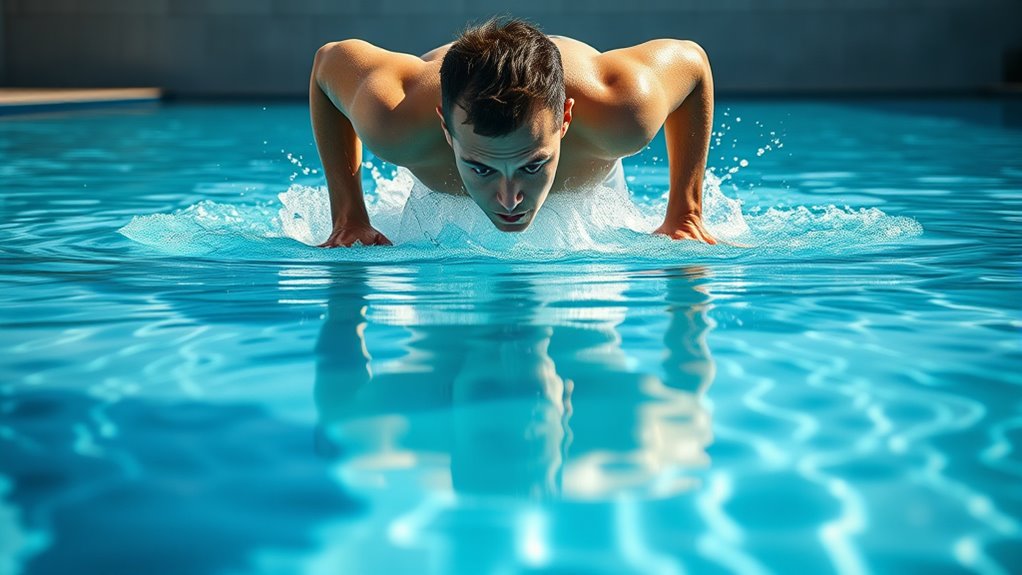
Water push-ups are an effective way to build upper body strength because the resistance of the water challenges your muscles with every movement. As you push against the water, your chest, shoulders, and triceps work harder than on land, increasing muscle activation. The water’s resistance slows your movement, forcing you to control each rep and engage stabilizing muscles. To perform the exercise, place your hands on the pool edge or a submerged surface, keep your body straight, and lower yourself toward the water before pressing back up. This variation reduces joint stress while maximizing muscle engagement. Incorporating resistance training in the water enhances muscular endurance, boosts upper body power, and adds variety to your workouts. They’re a simple yet effective way to challenge yourself in the pool.
Side Leg Raises for Hip and Thigh Toning
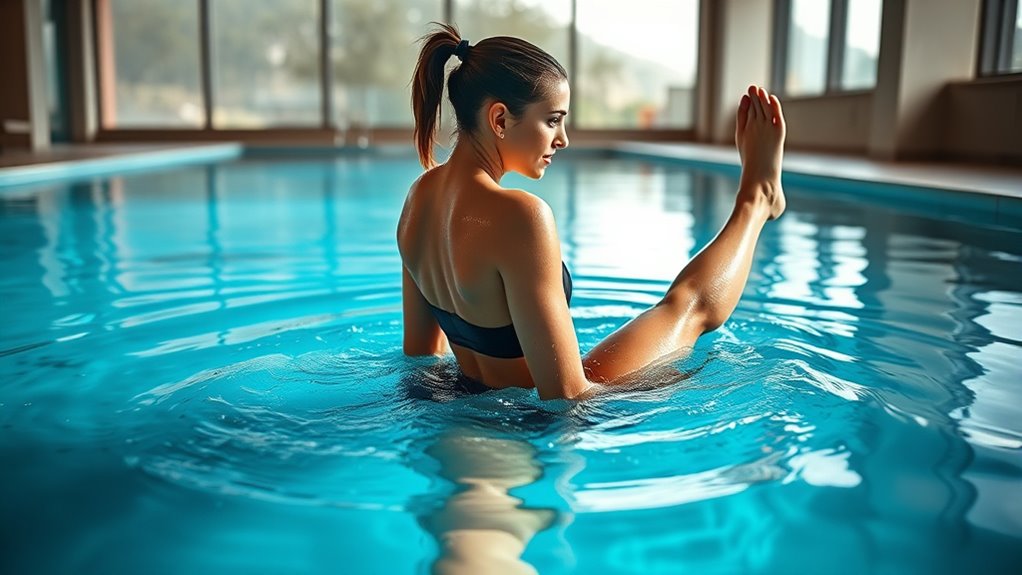
Building on upper body strength, incorporating side leg raises in the pool can effectively target your hips and thighs. This exercise enhances muscle tone, balance, and flexibility without added impact. To perform:
- Stand near the pool wall for support, holding onto it with one hand.
- Lift your leg sideways, keeping it straight and controlled.
- Hold briefly at the top, then lower slowly.
- Switch sides and repeat.
Keep your core engaged and move smoothly to maximize benefits. Focus on controlled movements to target the hip abductors and thigh muscles. This exercise increases lower-body strength and stability, helping to shape and tone your hips and thighs. It’s simple, effective, and perfect for adding variety to your pool workout routine. Incorporating proper technique and form ensures you get the most out of each movement while reducing the risk of injury.
Swimming Strokes for Full-Body Conditioning

Have you considered how different swimming strokes can provide a thorough workout for your entire body? Each stroke targets various muscle groups, offering a comprehensive conditioning session. Freestyle engages your arms, shoulders, chest, and core as you streamline and propel yourself forward. Breaststroke emphasizes the chest, inner thighs, and glutes while requiring controlled breathing. Backstroke strengthens your back, shoulders, and triceps, helping improve posture. Butterfly is intense, working nearly every muscle in your body—core, legs, arms, and shoulders—while boosting cardiovascular endurance. Mixing these strokes in your workout keeps things balanced and challenging. Using an endless pool allows you to switch strokes seamlessly, ensuring full-body engagement and helping you build strength, endurance, and flexibility efficiently.
High-Intensity Interval Training (HIIT) in Water

High-Intensity Interval Training (HIIT) in water offers an effective way to boost your fitness by combining short bursts of intense effort with brief recovery periods. Water’s natural resistance makes your workout more challenging, helping you burn calories and build strength efficiently. To maximize your session, consider these key strategies:
Boost fitness with water HIIT—short, intense efforts using resistance for maximum calorie burn and strength.
- Alternate between 20-30 seconds of all-out effort and 10-15 seconds of rest.
- Incorporate exercises like sprinting, jumping, or fast kickboard drills.
- Use the pool’s resistance to increase muscle engagement without added impact.
- Keep shifts quick to maintain the intensity and metabolic boost.
This approach not only improves cardiovascular health but also enhances muscular endurance, all while minimizing joint stress. HIIT in water offers a versatile, low-impact way to elevate your fitness routine.
Frequently Asked Questions
Can Beginners Safely Perform These Pool Exercises Without Prior Experience?
Yes, beginners can safely perform these pool exercises, but you should start slowly and listen to your body. It’s crucial to gain some basic swimming skills and understand proper techniques first. Consider consulting a trainer or instructor for guidance, especially if you’re new to water workouts. Always begin with gentle movements, gradually increase intensity, and make sure the pool environment is safe and suitable for your fitness level.
How Often Should I Incorporate These Exercises Into My Workout Routine?
You should schedule swimming sessions two to three times weekly to see steady strength and stamina. Consistency is key, so stick to a set schedule that fits your lifestyle. Mix moderate moves with more intense exercises to maximize your workout benefits. Remember, gradually increasing your frequency and intensity helps prevent injury and promotes progress. So, make a mindful, manageable plan, and watch your wellness and workout wonders grow.
Are There Any Specific Safety Precautions for Using an Endless Pool?
Yes, there are safety precautions you should follow when using an endless pool. Always supervise children or inexperienced swimmers, and never swim alone. Check the pool for any hazards or debris before use. Make sure you’re familiar with the pool’s controls and safety features. Avoid overexertion, and listen to your body. If you feel dizzy or uncomfortable, exit the pool immediately to prevent accidents or injuries.
What Equipment, if Any, Is Needed for These Exercises?
You don’t need much equipment to turn your endless pool into a fitness haven. Just your body and a splash of motivation—no fancy gadgets required. For added variety, grab some waterproof dumbbells or resistance bands. If you’re feeling fancy, a waterproof stopwatch or floating kickboard can spice things up. Basically, your pool’s the gym, and all you need is a little creativity and a splash of determination.
Can These Exercises Help With Injury Rehabilitation or Recovery?
Yes, these exercises can definitely aid in injury rehabilitation and recovery. You can target specific muscles and gradually build strength in a controlled environment. The adjustable resistance and shallow water make it easier to perform low-impact movements, reducing strain on your joints. As you progress, you’ll regain mobility and flexibility more safely. Just make sure to consult your healthcare provider before starting any new exercise routine for recovery.
Conclusion
With these ten exercises, you can turn your endless pool into a personal fitness haven—no need for a time machine, just your determination. Whether you’re channeling your inner Aquaman or just looking to stay in shape, these moves pack a punch. So plunge in like a modern-day hero, and watch your strength, endurance, and flexibility soar. Who knew working out could feel like a scene out of your favorite adventure flick?
